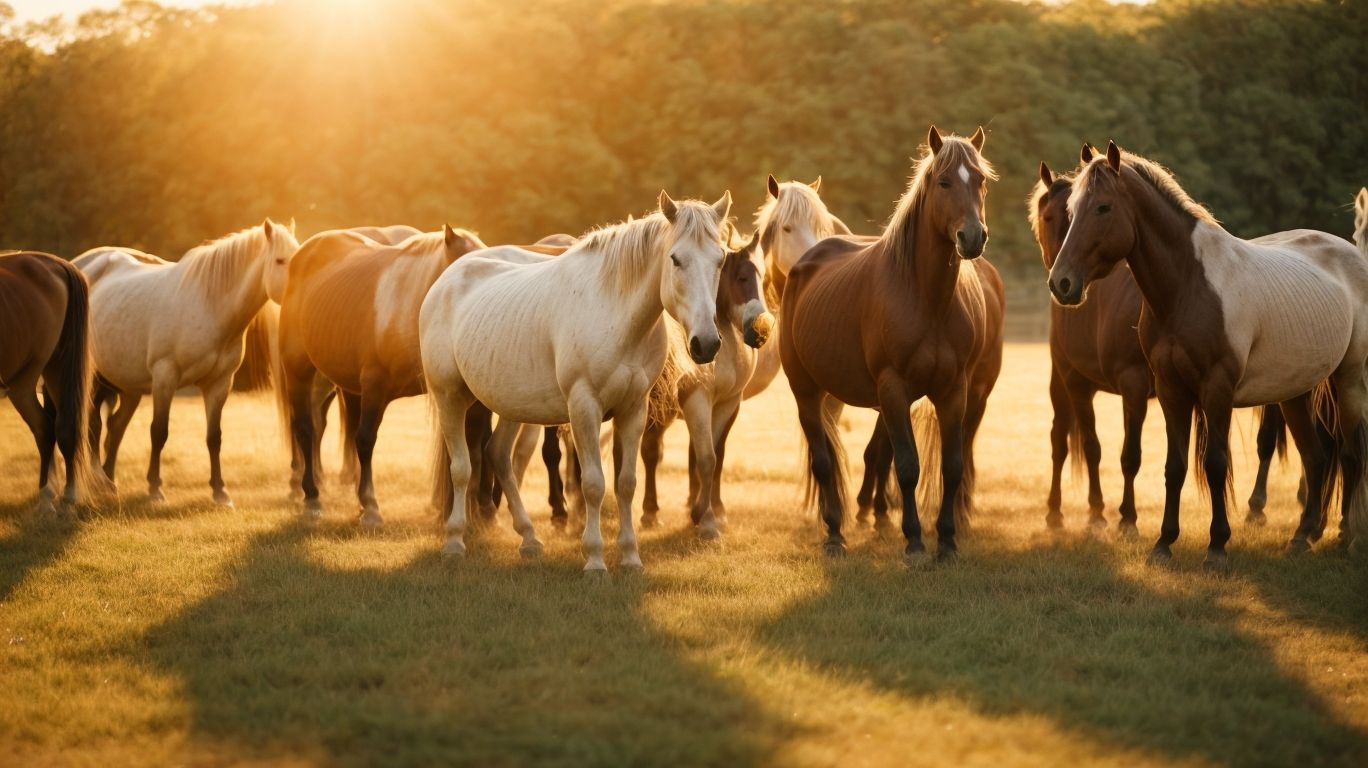Horse behavior management is essential for ensuring the well-being and safety of our equine companions. One common behavior that horse owners may face is herd-bound behavior. Understanding and effectively managing this behavior is crucial. When horses exhibit herd-bound behavior, they become overly attached to their herd mates and struggle to function independently. This article will delve into the causes and impact of herd-bound behavior, as well as provide strategies for managing it. By implementing appropriate management techniques, horse owners can foster trust, improve focus and attention, and ensure a more harmonious partnership with their horses. Consulting professionals such as veterinarians, trainers, or behaviorists can also offer valuable guidance and support in managing herd-bound behavior effectively.
Key takeaways:
- Herd-bound behavior in horses is caused by various factors including lack of socialization, separation anxiety, over-attachment to other horses, and past traumatic experiences.
- Herd-bound behavior can lead to difficulties in training, limited focus and attention, and safety concerns.
- To manage herd-bound behavior, gradual desensitization, building trust and confidence, providing mental stimulation, and establishing clear boundaries are essential.
Understanding Horse Behavior Management

Photo Credits: Www.Horsespeakeducation.Com by Edward Anderson
Understanding horse behavior management is crucial when it comes to creating a balanced environment and fostering a strong bond with your horse. Here are key steps to consider:
Observation: Dedicate time to observe and comprehend your horse’s innate behavior and body language.
- Consistency: Establish consistent rules and routines to provide a well-structured and predictable atmosphere.
- Positive Reinforcement: Utilize positive reinforcement techniques, such as rewards and praise, to motivate desired behaviors.
- Clear Communication: Develop clear and effective communication skills to establish trust and mutual understanding.
- Appropriate Training: Employ training methods that align with your horse’s unique needs and learning style.
- Environment Enrichment: Offer suitable mental and physical stimulation to prevent monotony and promote natural behaviors.
- Professional Guidance: Seek advice from experienced trainers or equine professionals to tackle specific behavioral issues.
What Is Herd-Bound Behavior in Horses?
Herd-bound behavior in horses, also known as herd-bound behavior, refers to a condition where a horse becomes excessively attached or dependent on other horses in its herd. This behavior can include anxiety, restlessness, and resistance to leaving the presence of other horses. Understanding what herd-bound behavior is is important because it can impact a horse’s training, focus, and safety. Herd-bound behavior can be caused by factors such as a lack of socialization, separation anxiety, over-attachment to other horses, or past traumatic experiences. Effective management strategies for dealing with this behavior include gradual desensitization, building trust and confidence, providing mental stimulation, and establishing clear boundaries. It is also helpful to seek guidance from professionals like veterinarians, trainers, or behaviorists for additional support.
Causes of Herd-Bound Behavior

Photo Credits: Www.Horsespeakeducation.Com by Austin Baker
Horses are magnificent creatures, but sometimes their behavior can present challenges. In this section, we’ll uncover the causes of herd-bound behavior in horses. From a lack of socialization to separation anxiety, and over-attachment to other horses, these factors can greatly impact how horses interact within a herd. We’ll also explore the potential effects of past traumatic experiences on herd-bound behavior. Get ready to dive deep into understanding the underlying reasons behind this behavior in our equine companions.
Lack of Socialization
Lack of socialization in horses can lead to herd-bound behavior, where they become overly dependent on their herd mates. This behavior can be problematic for their training, focus, and safety. Horses that haven’t been adequately socialized may struggle with interacting and functioning independently. To address this issue, gradual desensitization techniques can be employed to assist horses in becoming more comfortable being alone or away from their herd. Building trust and confidence through positive reinforcement and providing mental stimulation can also help minimize herd-bound behavior. Seeking guidance from professionals such as veterinarians, trainers, or behaviorists can offer further assistance in managing this issue.
Pro-tip: Regularly exposing horses to new environments and socializing them with other horses can effectively prevent or mitigate herd-bound behavior.
Separation Anxiety
Separation anxiety is a common form of herd-bound behavior in horses. It is characterized by the horse experiencing distress or anxiousness when separated from its herd members. This can cause a multitude of issues, including difficulty in training, limited focus and attention, as well as safety concerns. To effectively address separation anxiety, gradual desensitization techniques can be implemented to assist the horse in becoming more at ease with being alone. Additionally, building trust and confidence, providing mental stimulation, and establishing clear boundaries are essential in alleviating separation anxiety. Seeking guidance from a veterinarian, trainer, or behaviorist, as well as considering alternative therapies, are also viable strategies for effectively managing separation anxiety in horses.
Over-Attachment to Other Horses
Over-attachment to other horses is a frequent issue in equines that can result in behavioral problems and impede training progress. Addressing this issue effectively is crucial to ensure the horse’s well-being and enhance their overall behavior.
- Provide socialization opportunities with other horses in a controlled environment to avoid excessive dependency.
- Implement gradual separation exercises to help the horse become more independent and comfortable being away from their preferred companion.
- Offer mental stimulation through engaging activities and toys to divert the horse’s attention and reduce their reliance on other horses.
- Establish clear boundaries and consistent training routines to develop trust and confidence in the horse’s bond with their handler.
Past Traumatic Experiences
Past traumatic experiences can significantly contribute to herd-bound behavior in horses. These distressing events can vary from instances of physical abuse to being present during traumatic incidents. When a horse endures such trauma, it is not uncommon for them to exhibit signs of fear, anxiety, or stress, which often result in a strong attachment to their herd. This attachment acts as a coping mechanism and can pose difficulties when attempting to separate the horse from its companions. To effectively manage herd-bound behavior derived from past traumatic experiences, it is crucial to provide the horse with a safe and secure environment. Additionally, gradually exposing them to triggers and collaborating with equine professionals to address any underlying emotional issues is essential.
Impact of Herd-Bound Behavior

Photo Credits: Www.Horsespeakeducation.Com by Benjamin Walker
Herd-bound behavior in horses can have a significant impact on various aspects of their management. From training difficulties to limited focus and attention, and even safety concerns, this section explores the consequences of herd-bound behavior. Unraveling the complexities behind these challenges, we discover the remarkable insights that shed light on effective strategies for managing and mitigating the negative effects of this behavior in our equine companions.
Difficulty in Training
Training can become difficult when horses exhibit herd-bound behavior. This behavior can impede progress and make it hard to achieve desired results. To overcome this challenge, here are a few steps to consider:
- Establish a solid foundation of trust and communication with the horse.
- Gradually desensitize the horse to separation from its herd mates.
- Implement systematic training exercises to improve focus and attention.
- Utilize positive reinforcement techniques to motivate and reward the horse.
- Provide mental stimulation and variation in training routines to keep the horse engaged.
- Consult a professional trainer or behaviorist with experience in dealing with herd-bound behavior.
By following these steps, trainers can successfully address the difficulties associated with training horses exhibiting herd-bound behavior and enhance their overall training experience.
Limited Focus and Attention
When dealing with herd-bound behavior in horses, one of the major challenges is limited focus and attention. Horses that have a restricted ability to concentrate and stay engaged can find it difficult to prioritize training or tasks at hand. This can significantly impede their progress and success in various activities. To address this issue, it is crucial to implement strategies that enhance focus and attention. Gradual desensitization, building trust and confidence, providing mental stimulation, and establishing clear boundaries are some effective methods to manage limited focus and attention in herd-bound horses. Consulting professionals such as veterinarians, trainers, or behaviorists can also offer valuable guidance in overcoming this challenge.
Safety Concerns
Herd-bound behavior in horses can give rise to safety concerns for both the horse and the handler. It is crucial to address this behavior in order to guarantee a secure environment. Some potential safety concerns linked to herd-bound behavior consist of:
1. Difficulty in handling: Horses that exhibit herd-bound tendencies may present challenges in their handling, thereby making it arduous for the handler to lead or control them.
2. Risk of injury: Separation from their herd can cause anxiety or agitation in horses displaying herd-bound behavior, consequently augmenting the likelihood of harm to themselves or others.
3. Distraction and lack of focus: Horses affected by herd-bound behavior may evidence limited focus and attention, hence making it taxing for them to respond to training cues or remain focused during activities.
By appropriately addressing herd-bound behavior through training, desensitization, and facilitating mental stimulation, it is possible to minimize these safety concerns, thereby ensuring a horse that is safer and easier to manage.
Managing Herd-Bound Behavior

Photo Credits: Www.Horsespeakeducation.Com by Charles Garcia
In the world of horse behavior management, one important aspect to address is managing herd-bound behavior. This section will explore various strategies to tackle this issue, including gradual desensitization, building trust and confidence, providing mental stimulation, and establishing clear boundaries. By understanding and implementing these approaches, we can effectively address herd-bound behavior in our horses and create a harmonious environment for both horse and handler.
Gradual Desensitization
Gradual desensitization is a highly effective technique for managing herd-bound behavior in horses. This process involves systematically exposing horses to the stimuli that trigger their anxiety, in a controlled and gradual manner. Here, we outline the steps involved in implementing gradual desensitization:
- Identify the specific triggers that cause the herd-bound behavior.
- Begin with a mild version of the trigger and slowly introduce it to the horse.
- Monitor the horse’s reaction and ensure they remain below their stress threshold.
- Gradually increase the intensity of the trigger over time, while ensuring the horse remains comfortable.
- Reward the horse for calm behavior during each stage of desensitization.
- Repeat the process with different triggers or in different environments to generalize the training.
By utilizing gradual desensitization, horse owners can effectively help their horses overcome their herd-bound behavior and develop greater confidence and independence.
Building Trust and Confidence
Building trust and confidence is essential when managing herd-bound behavior in horses. By nurturing a strong bond with your horse, you can effectively alleviate their anxiety and enhance their willingness to cooperate. Here are several strategies to consider:
- Implement consistent and patient handling methods to establish a sense of security.
- Utilize positive reinforcement techniques, such as clicker training, to cultivate trust and reinforce desired behaviors.
- Introduce your horse gradually to new environments or situations to boost their confidence.
- Engage in groundwork exercises that prioritize clear communication and respect.
- Employ gentle desensitization exercises to assist the horse in overcoming fears and anxieties.
- Maintain regular and structured routines to provide a sense of stability and predictability.
By incorporating these proven techniques and dedicating time to build trust and confidence, you can effectively address your horse’s herd-bound behavior and elevate their overall demeanor and performance.
Providing Mental Stimulation
Providing mental stimulation for herd-bound horses is crucial to help alleviate their anxiety and keep them engaged. Here are some ways to provide mental stimulation:
- Interactive Toys: Use treat-dispensing toys or puzzle feeders to provide mental stimulation for the horse by keeping them occupied and engaged.
- Obstacle Courses: Set up various obstacles and challenges that require problem-solving skills for the horse to navigate, thereby providing mental stimulation.
- Training Exercises: Introduce new commands and tricks to challenge the horse’s mind and improve their focus, thus providing mental stimulation.
- Scavenger Hunts: Hide treats or objects around the pasture to stimulate the horse’s natural foraging instincts and provide mental stimulation.
One example of providing mental stimulation is the case of a herd-bound horse named Rocky. His owner implemented a rotating schedule of different activities, including clicker training, trail rides, and even playing soccer with a large ball. By consistently providing mental stimulation, Rocky’s separation anxiety significantly decreased, enabling him to develop more independence and confidence.
Establishing Clear Boundaries
- Establishing clear boundaries is crucial in managing herd-bound behavior in horses. Here are some ways to achieve this:
- Consistent Leadership: Establish yourself as the leader and maintain consistent expectations and boundaries with your horse.
- Groundwork Exercises: Engage in groundwork exercises that focus on respect, obedience, and moving away from pressure.
- Desensitization: Gradually expose your horse to various stimuli and build their confidence in new environments.
- Establish Routines: Establish predictable routines for feeding, grooming, and exercise to create a sense of stability and structure.
- Positive Reinforcement: Reward and reinforce desired behaviors to encourage your horse to follow boundaries willingly.
Fact: Horses thrive in environments where clear boundaries are established, as it provides them with a sense of security and guidance.
Working with Professionals

Photo Credits: Www.Horsespeakeducation.Com by Kyle Williams
When it comes to managing herd-bound behavior in horses, working with professionals is essential. In this section, we’ll explore the different avenues you can take to address this issue. Whether it’s consulting a veterinarian for medical interventions, seeking guidance from a skilled trainer or behaviorist, or considering alternative therapies, each sub-section offers a unique approach that can help you effectively address and manage herd-bound behavior in your horses. Let’s dive into the expertise and support that professionals bring to the table.
Consulting a Veterinarian
When it comes to dealing with herd-bound behavior in horses, it is crucial to consult a veterinarian. Consulting a veterinarian is essential as they have the expertise to assess the horse’s physical health and rule out any underlying medical conditions that might be contributing to the behavior. Additionally, a veterinarian can provide valuable guidance on the appropriate training methods and behavior modification techniques to effectively address herd-bound behavior. It’s important to remember that every horse is unique, and a veterinarian can offer personalized advice tailored to your horse’s specific needs. To prevent and address herd-bound behavior early on, it is recommended to schedule regular veterinary check-ups and maintain open communication with your veterinarian. Taking these proactive steps can help prevent herd-bound behavior from becoming a more significant issue in the future.
Seeking Help from a Trainer or Behaviorist
Seeking help from a Trainer or Behaviorist can be highly beneficial when dealing with herd-bound behavior in horses. Here are some recommended steps to follow when seeking professional assistance:
- Research reputable Trainers or Behaviorists who specialize in equine behavior.
- Contact the Trainer or Behaviorist to discuss your specific concerns and goals.
- Schedule an initial consultation or evaluation with the Trainer or Behaviorist to assess the horse’s behavior and determine the best approach.
- Follow the recommendations provided by the Trainer or Behaviorist for training techniques and exercises tailored to address the herd-bound behavior.
- Attend regular training sessions with the professional to receive ongoing guidance and support.
- Maintain open communication with the Trainer or Behaviorist throughout the training process, informing them about any progress, setbacks, or questions that may arise.
Considering Alternative Therapies
Considering alternative therapies can be beneficial in managing herd-bound behavior in horses. These therapies can provide additional support and complement other behavior management techniques. Here are some alternative therapies to consider:
- Equine-assisted therapy: This therapy involves incorporating horses into therapeutic activities to address emotional and behavioral issues. It can help in building trust and improving overall well-being.
- Acupuncture: Acupuncture can help relieve stress and anxiety in horses. It involves the insertion of thin needles at specific points to stimulate the body’s natural healing response.
- Herbal remedies: Certain herbs and supplements, such as chamomile or valerian root, may have calming effects on horses. It is important to consult with a veterinarian before using any herbal remedies.
- Massage therapy: Equine massage can help release tension and promote relaxation in horses. It can be particularly beneficial for horses experiencing physical discomfort due to herd-bound behavior.
Pro-tip: Experimenting with different alternative therapies can help you find the most effective approach for managing herd-bound behavior in your horse. Always consult with professionals and monitor your horse’s response to ensure their well-being.
Some Facts About Horse Behavior Management – Managing Herd-Bound Behavior:
- ✅ Buddy sour behavior refers to a horse getting upset when separated from another horse, regardless of how long they have been buddies. (Source: Our Team)
- ✅ Buddy-sour horses can be dangerous and not focused on their rider or surroundings. (Source: Our Team)
- ✅ Training the horse to develop emotional control and improve responses to cues is the solution for managing herd-bound behavior. (Source: Our Team)
- ✅ Enlisting the help of a friend who will ride the horse’s buddy can be beneficial in addressing herd-bound behavior. (Source: Our Team)
- ✅ Prior to the training ride, both riders should work on small maneuvers to improve their horses’ responses to rein and leg cues. (Source: Our Team)
Frequently Asked Questions
What is herd-bound behavior in horses?
Herd-bound behavior refers to a horse getting upset when separated from another horse, regardless of how long they have been buddies. It is a form of gregarious behavior where the horse wants to stay with its pasture mate or herd.
Why is herd-bound behavior a concern?
Herd-bound horses can be dangerous as they may become unfocused on their rider or surroundings. This can lead to the horse exhibiting undesirable behaviors or potentially putting the rider in a dangerous situation.
How can herd-bound behavior be addressed?
Herd-bound behavior can be addressed by training the horse to develop emotional control and improve responses to cues. Enlisting the help of a friend who will ride the horse’s buddy can be beneficial in the training process.
What are some specific approaches to managing herd-bound behavior?
Prior to the training ride, both riders should work on small maneuvers to improve their horses’ responses to rein and leg cues. The goal is to get the horse slightly upset and then calm, repeating this process to help them learn to focus on the rider. Short, specific requests are used to keep the horse’s attention on the rider.
How can training the horse to respond to cues when upset be achieved?
During the preparation work, the horses are trained to speed up, slow down, move their hips or shoulders, and drop their heads on cue. Each request is accompanied by rein or leg pressure, which is released as soon as the horse complies. Through practice, the horse will learn to respond to cues even when upset, similar to answering a phone call.
What is the ultimate goal in managing herd-bound behavior?
The ultimate goal is to have the horse focused on the rider, rather than their buddy, even when separated. This can be achieved by conditioning the horse to respond to cues, using techniques such as asking the horse to drop their head and releasing pressure when they comply.
